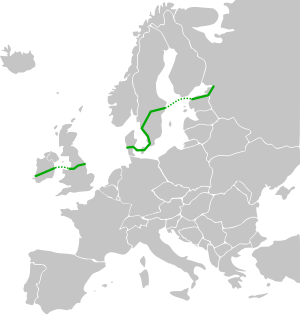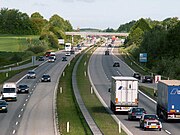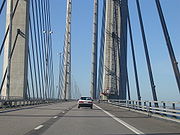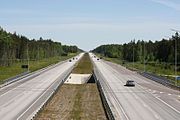European route E20
| E20 | |
|---|---|
 | |
| Major junctions | |
| West end | Shannon Airport (Ireland) |
| East end | St Petersburg (Russia) |
| Location | |
| Countries | Ireland, United Kingdom, Denmark, Sweden, Estonia, Russia |
| Highway system | |
The European route E 20 is part of the United Nations International E-road network.
It runs roughly west-east through Ireland, the United Kingdom, Denmark, Sweden, Estonia and finally Russia. The length is 1,880 km (1,170 mi).
The road is not continuous, at three points, a sea crossing is required. Roll-on/roll-off ferries make the crossings from Dublin to Liverpool and from Stockholm to Tallinn. No vehicle-carrying vessels traverse the North Sea from Kingston-upon-Hull to Esbjerg (as of 2013).
Route
Ireland
The initial section of the E 20 from Shannon Airport to Dublin via Limerick is approximately 228 km long and is only partially signed, along the M7/N7. The section from Shannon Airport to east of Limerick is mainly dual carriageway, with a short section of motorway as part of the Limerick Southern Ring Road. The Shannon Tunnel, opened on 16 July 2010, completed the bypass of Limerick. The section from Limerick to Naas is motorway (M7), and the final section from Naas to Dublin is dual carriageway (N7). A ferry must be used from Dublin to Liverpool.
United Kingdom
E 20 follows the A5080 from Liverpool to Huyton, the M62 from Huyton to South Cave, and the A63 from South Cave to Kingston upon Hull. The route length across the UK is 205 km in total, it is not signposted in the UK.
There is no ferry between Kingston upon Hull and Esbjerg. An alternative ferry is available from Harwich (350 km/220 mi from Kingston upon Hull) to Esbjerg.
Denmark
In Denmark E 20 is a motorway from Esbjerg to the Oresund Bridge. The length of the Danish part is 315 km (196 mi).
It passes along the Great Belt Bridge which consists of two parts of 6 + 6 km.
The Great Belt Bridge and Oresund Bridge are tolled, both with more than €30.[1][2] The Oresund Bridge is 8 km and there is a 4 km tunnel on the Danish side of the Sund.[citation needed] The road crosses the border between DK/S on the bridge.
Between Køge and Copenhagen the road has three E-road numbers (also E 47 and E 55).
Sweden
In Sweden, E 20 is a motorway from the Øresund Bridge in Malmö to Nääs 30 km east of Gothenburg, a 320 km (200 mi) long motorway. Furthermore, it is a motorway most of the route from Vretstorp (20 km (12 mi) west of Örebro) to Stockholm.
The Swedish part of E 20 is 770 km (480 mi) long. Its extent is shared with E 6 along a 280 km (170 mi) long stretch, with E 18 along 50 km (31 mi) and with E 4 along 35 km (22 mi).
The part through Stockholm has very heavy traffic, including the most heavily trafficked road in Scandinavia[citation needed], Essingeleden (160 000 vehicles/day). There is often congestion on this stretch and on the part of E 20 that is located on streets in central Stockholm. Travellers intending to catch a ferry must include some margin, about 30 additional minutes, to account for possible delays. A new tunnel, "Norra länken", is being built north of the inner city, which would be part of the E 20. Norra Länken will alleviate some of the congestion in central Stockholm, but not along Essingeleden. The tunnel is expected to be completed in 2015. If carried out, the planned Förbifart Stockholm bypass will divert traffic from Essingeleden.[citation needed]
Between Stockholm and Tallinn a car ferry departs daily, taking 15 hours. The port in Stockholm is located at Lilla Värtan, about 4 km northeast of the central core of the city.
Estonia
In Estonia, E20 follows the route of national main road nr. 1 (Tallinn–Narva). The E20 across Estonia is partially expressway, for 80.7 km east of Tallinn to Aaspere (section till km 90.5 is currently under construction) and a section between Kohtla-Järve and Jõhvi (km 155.9–163.2). The remainder being single carriageway. The distance from Tallinn to the Russian border at the Narva River is 218 km.
Russia
In Russia, the route takes the Narva Highway also listed in the Russian road numbering system as the A180 route (formerly known as the M11 route) running from Ivangorod to Saint Petersburg as a dual-line highway. The distance from Ivangorod to Saint Petersburg is 142 km. The border control facilities at the Estonia-Russia crossing are equipped and being operated for a limited amount of traffic on both sides of the border. The border crossing requires a reservation, however the waiting lines still can extend for many hours and even days.[3]
-
The M62 passes Scammonden Reservoir in West Yorkshire
-
On Oresund Bridge
-
East coast of Oresund, between Malmö and Helsingborg
-
Near Jägala, Estonia









